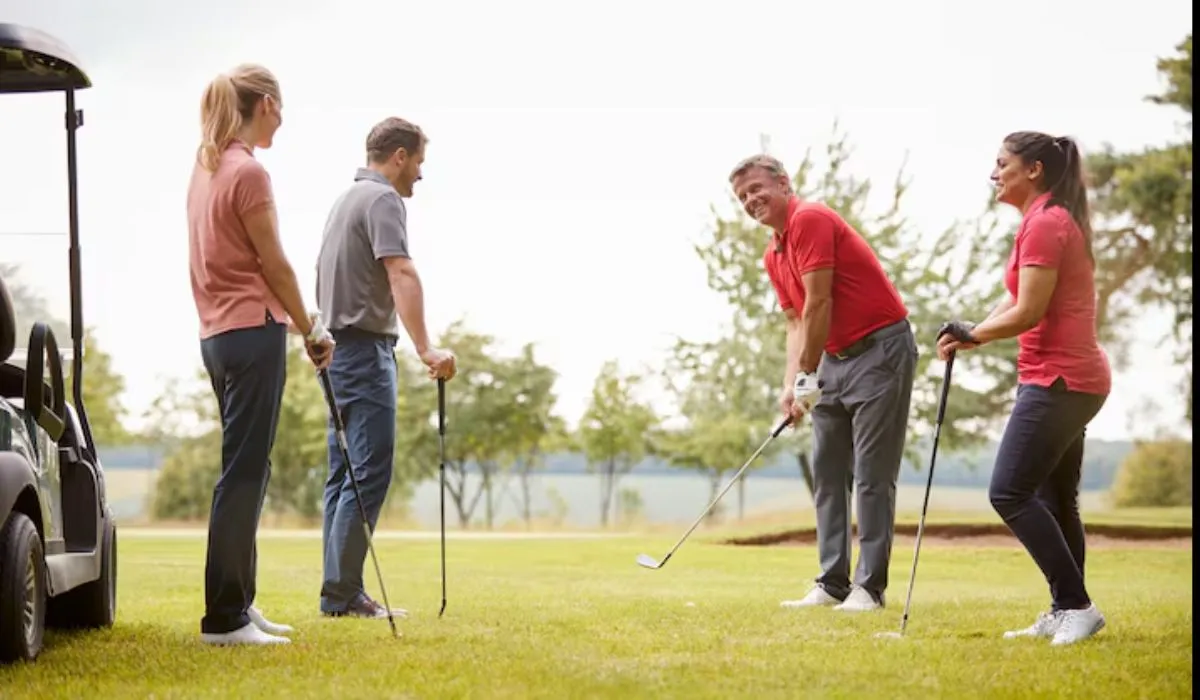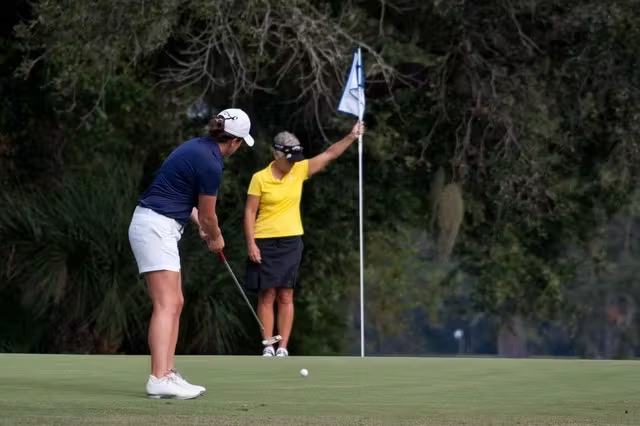Easy does it, Welcome to the wonderful world of golf! It is a skill-based game, a game of patience, and beautiful outside areas. It is intimidating to begin something new. But do not worry. This is a guide that is going to put you by the hand and lead you through each and every step.
Imagine that this is your own golf lesson. We will discuss all the aspects such as what to wear and how to complete your first round among others. This aims at making the golf game enjoyable and simple to learn. You are about to embark on your new adventure!
How to Play Golf for Beginners Step by Step: Your First Swing?
The beginning of golf is like construction of a house. The foundation must be well in advance of the addition of the walls and roof. In golf, your starting point is to know the equipment, to know their rules and to know the fundamental movements. One step at a time we will establish this base.
Getting Started: Your First Golf Gear

There is no need to purchase everything at once. Start with the essentials.
What Clubs Do You Need?
Golf clubs come in a complete set of 14 clubs. But a novice need not have so many. The half-set or few important clubs may get you started. Find a novice golf club set. These are made to be more lenient and simpler to strike.
The most significant clubs a new player will be interested in are:
- A Driver: This is on the first shot on long holes. The club is the one that has the largest head.
- A Fairway Wood: also known as a 3-wood or a 5-wood. It is excellent of long shots on the grass.
- A 7-Iron: It is an ideal midrange iron that is good to begin with. It can easily be controlled compared to other irons.
- A Pitching Wedge: This club will assist in hitting the ball high into the air to make a short shot around the green.
- A Putter: This is the club that you roll the ball in the green onto the hole.
- A Hybrid Club: It is a great beginner club. It is a combination of a wood, and an iron, and plays so easy to hit at numerous points.
Choosing the Right Golf Balls
You will find a lot of golf balls that cost a lot of money. At present, it is only necessary to purchase a box of cheap, durable golf balls that are used by beginners. You may even make a few mistakes in the process of learning and it is all right! At first, do not spend much money on balls.
Your Golf Bag and Other Helpful Items
You will require a bag to put your clubs. An ultra-light carry bag is a decent beginning. Other items that are necessary include:
- Golf Tees: These are tiny sticks that you use in placing your ball on the initial swing on a hole.
- A Ball Marker: This is a small, flat coin-shaped item to use to identify the position of your ball on the green.
- A Divot Tool: This is something that you use to repair the holes that your ball will create on the green.
- Golf Glove: This will assist in a better grip of the club. The one is normally played on your lead hand (on the left hand of the right-handed players).
What to Wear on the Golf Course
Beginners need to dress properly in golf. The majority of the courses have a dress code. A basic dressing code is a collared shirt (such as polo shirt) and long trousers or shorts that reach up to the knees. Do not wear jeans, tank tops or gym clothes. It is also worth having comfortable golf shoes with soft spikes, which will work with hard tennis shoes at the beginning.
Learning the Basic Golf Swing
The swing of the golf club may appear complex, but we can analyze it and divide it into easy steps.
The Perfect Beginner Golf Grip
The most important thing is the way you hold the club. The clubface is controlled by a good grip. One false grip and the ball may go anywhere!
- Keep the club in your lead hand (left hand righties). The grip must be in the shape of a diagonal of your fingers.
- Wrap up your fingers around the club and use your other hand on the club. You want to face each other with the palms.
It must be like handshaking with the club. This is one of the basic styles of golf grip. Do not grip too tightly! A tight, yet loosely-stretched grip is the most appropriate.
Your Golf Stance and Posture
- It is also important to stand properly as it is to hold the club.
- Keep the feet at a shoulder distance.
- Tilt forward with the hips and not the waist. Keep your back comparatively straight.
- Keep your arms loose at your shoulders.
- Do bend the knees.
This is the right stance in golf, which is recommended to new golfers. It provides you with a steady support on which to swing.
How to Play Golf for Beginners Step by Step: On the Course?

You are armed with your outfit and you have swivelled your swing. You are now prepared to take the course!
Learning the Golf Course Layout.
A golf course has 18 holes. Each hole has a:
- Tee Box: This is the point of beginning of every hole.
- Fairway: This refers to the short and well cut grass which runs to the green. It is the best place to be.
- The Rough: This is the fairway grass that grows along the fairway sides. It is harder to hit from.
- Dangers: These dangers are bunkers (sand traps) and water (lakes or ponds). Try to avoid these!
- The Green: This is the very short grass on which the hole has been found. You use your putter here.
The Goal of the Game: A Simple Explanation
The task is easy: play your ball out of the tee box and as much as possible, only a few shots will allow you to win. One shot is considered a single "stroke." The one who has the fewest strokes at the end of the round is the winner.
Golf Etiquette 101: Unwritten Rules
Golf etiquette among the beginners entails being safe and respectful.
- Be Quiet: You are not allowed to speak or make noise at a time that a player is hitting his/her shot.
- Stay Still: Stand and get out of the view of the player who is hitting.
- Play Quickly (Pace of Play): Be with the pack that is in front of you. Spend not long in searching after a lost ball.
- Look After the Course: Rake bunkers where you have hit. Mark your balls on the green. Repair your divots (pieces of grass that you struck) on the fairway.
Let's Play a Hole: A Step-by-Step Walkthrough
Accomplish these steps in each hole you play.
- Step 1: Tee Off. At the tee box place your ball on a tee. Swing your first with your driver or wood. This is called your "drive."
- Step 2: Hit Your Approach Shot. Go where your ball struck. When it is on the fairway, then you use an iron such as your 7-iron to strike the ball towards the green.
- Step 3: The Short Game. Your ball is at the green yet not on it. A "chip shot" will be a pitching wedge that will help to put the ball on the green and move it toward the hole.
- Step 4: Putting. When you have a ball on the green, putter with it. This is aimed at rolling the ball into the hole. It is okay when you have to have more than one putt.
The Secret of the Short Game: Mastering the Short Game.
The close shot in golf involves the shots that are struck around the green. Here you may save many a stroke!
You may learn also :- The Best Golf Instruction for Beginners: A Complete Guide to Getting Started
Mastering the Short Game: Your Secret Weapon
A low running shot is called a chip shot. Play with your pitching wedge or 9-iron.
- Keep your feet beside each other.
- Lean forward on your front foot.
- Use a little, slow motion swing, mainly using your shoulders.
The ball will shoot out in the air and roll towards the hole. It is a simple method of chipping that amateurs can use.
Putting Like a Pro: It's All About Feel
- Placing is to do with distance and direction.
- Balance by keeping the feet separated.
- Your eyes must be over the ball.
- Draw a pendulum-like motion of your shoulders and arms. Your wrists should not break.
- Read the green. Find some slopes so that the ball will curve. This is one of the important beginner putting tips.
Golf Rules for Beginners: The Most Important Ones
There are certain rules which you do not need to know, but some are necessary.
- Play the Ball as It Lies: Never touch your ball unless you have been instructed to do so by a rule.
- Out of Bounds: When one hits their ball beyond the boundary of the course, they face a one stroke penalty and must play another ball where they had last hit the course.
- Lost Ball: When you lose your ball after 3 minutes, you receive a one penalty stroke and you have to use a new ball where you were last hit.
- Water Hazards: When your ball enters a water hazard there are places to choose. The most widespread is to replace a one-stroke with an abandoned ball behind the hazard.
Practice Makes Permanent: How to Get Better
The only way to be better is to practice right.
- Driving Range: This is where you take a practice of your complete swings using your driver and your irons. Make a good contact, not just hitting far.
- Putting Green: This is where you putt. It is usually free to use! Short putt and long putt practice.
- Drill: Do not strike balls aimlessly. Set a goal. As an instance, I will make 20 hits with my 7-iron and attempt to make 15 of them good.
Final Thoughts: You Are Ready to Play!
It is an enjoyable process to learn step by step on how to play golf as a beginner. It should be borne in mind that all golfers started as beginners. Being stuck on bad shots and lost balls is common to everyone. It is worth getting out and having fun out in the air.
Be patient with yourself. Be happy about the little things, such as a terrific drive or a long putt that you make. Golf is a sport which can be played all your life. Then pick up your clubs and get to the driving range and begin your adventure today.
Frequently Asked Questions
Q: What is the time taken to master on how to play golf?
A: It takes only one afternoon to learn the basics. However, it takes time and practice to be good and constant. After some weeks of practice, most people will be able to feel comfortable on the course.
Q: Is golf a costly sport at the start?
A: It may be, but it does not necessarily need to be. You can begin with a second hand set of clubs and only get a few lessons. Numerous courses in the public are extremely inexpensive. You should start out small and then invest more as you become a fan of the game.
Q: Is it necessary that I am a beginner and that I take golf lessons?
A: You may be able to learn with the help of online guides, but there is nothing quicker than having a number of lessons with a qualified PGA professional. They will be able to identify the errors that you are not able to see and provide you with unique golf coaching to develop the good habits at the beginning.
Q: What is the ideal score of a novice golfer?
A: You need not worry about your score in the beginning! Your first round is just an opportunity to complete 9 holes, enjoy and perhaps play one or two nice shots. Any score of less than 65 in 9 holes is good enough when a person is a true beginner. The 18 holes average is approximately 100.
Q: I am scared of playing on an actual course. What should I do?
A: It is a very familiar feeling! Begin on a par-3 or an executive course. They are shorter, less challenging and easier. Another option would be a less busy time to attend the course, such as a weekday afternoon.




